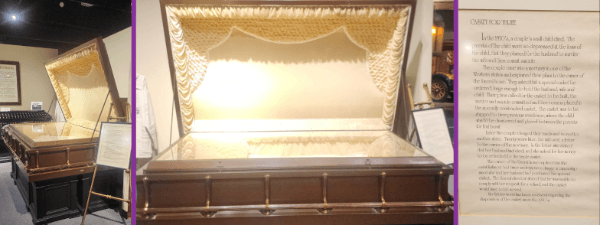On a recent trip to Houston, I made my hubby take me to the National Museum of Funeral History…yea, I know I’m one of the few that would use vacation time to visit…but it was actually pretty neat and we weren’t the only people there!!
After the lights came back on (there was a multi-block wide blackout that happened the second we walked in) I absolutely ate up all the exhibits. There were several really cool areas to look at:
- Celebrity funerals
- The history of hearses
- Embalming practices (and why they began)
- The exponential growth of cremation
- Funeral practices from around the world
- Presidential funerals
…but there was one ‘artifact’ that really stuck with me; a three person casket – which I think so perfectly tells the story of pregnancy loss and infant and child death.
In the 1930s a young child died. The parents were so distraught by this loss that the formulated a plan: The child’s father would murder the wife, and child’s mother, then commit suicide. But first, they needed to get all their affairs in order – so they reached out to their local funeral home to commission a special casket to be built.
The parents wanted a three person casket – big enough for mother, father, and their disinterred child. Given its size and specificity, this project would need to be custom built and take many months to complete.
While the casket was being built the parents began to heal their hearts and actually moved from the midwest to California. The funeral home did not hear from the parents again for almost 2 decades – until the 1950s – when the wife wrote the funeral home (remember, this was the 50’s; email wasn’t a thing and long distance calls were priced by the minute) stating that the husband had died and requested a full refund for the price paid for the three person casket. When the funeral home had to deny her request (the home had since been sold a time or two). After that she was never heard from again – and the beautifully large casket was given to the museum.
While I bet that many see this as ‘just’ a kookie little story, I can relate to this with every fiber of my being. I remember, in the very early days…all I wanted to do was ‘be with my Madelyn’. While I never got to the ‘real planning stage’ I was constantly thinking ‘what if I just forgot to turn the car and ran into that giant tree’, ‘what if I just missed this step and fell down this cement staircase’, or ‘that car is moving very fast – I bet they couldn’t stop if I jumped out in front of them at the last minute’…I never really wanted to die – but I also wasn’t interested in living.
And, just like in the story on the plaque next to the casket, my heart began to heal too. Does that mean that I still don’t miss my Maddie? Absolutely not! I miss her every single day.
But healing doesn’t mean forgetting. It doesn’t mean “moving on.” It means learning to carry the weight of grief and integrating it into your ‘new life’. It means finding ways to honor the love that still exists, even when the person you love is no longer physically here.
Standing in front of that massive three-person casket, I couldn’t help but think about all the ways grief can consume us, how it can make us feel like there’s no escape. It can literally bury you alive. But I also thought about how resilient the human heart is. How, even in the darkest moments, there can still be a flicker of hope, a chance for light to break through like a beacon.
That casket wasn’t just a relic of a family’s unimaginable pain; it was also a reminder of how grief can evolve. It starts as this all-consuming, heart-wrenching ache, but over time, it softens. It doesn’t go away, but it changes shape. It becomes something you can carry with you instead of something that weighs you down.
I left the museum that day with a renewed sense of gratitude—not just for my own journey but for the chance to share it with others. Because grief, as isolating as it can feel, is also something that connects us all. It’s universal. And when we share our stories, when we’re brave enough to say, “This is my pain, and this is how I’m befriending it,” we give others permission to do the same.
So, to anyone who feels like they’re drowning in their own grief, I want you to know: You’re not alone. Your pain is valid. Your story matters. And while I can’t promise that it will ever “get easier,” I can promise that you’ll get stronger. You’ll find ways to carry your grief—and your love—with you. And maybe, just maybe, you’ll find a way to turn your pain into something beautiful, too. If you’re ready, I’d love to hear your story—because together, we can remind each other that no one has to walk this path alone.
